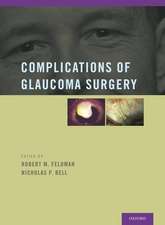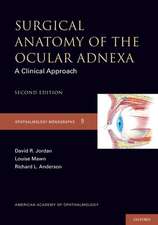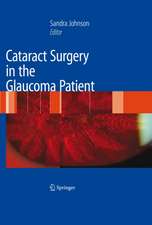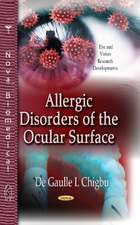Inflammation and Retinal Disease: Complement Biology and Pathology: Advances in Experimental Medicine and Biology, cartea 703
Editat de John D. Lambris, Anthony P. Adamisen Limba Engleză Hardback – 25 aug 2010
| Toate formatele și edițiile | Preț | Express |
|---|---|---|
| Paperback (1) | 1403.68 lei 43-57 zile | |
| Springer – 13 oct 2012 | 1403.68 lei 43-57 zile | |
| Hardback (1) | 1409.69 lei 43-57 zile | |
| Springer – 25 aug 2010 | 1409.69 lei 43-57 zile |
Din seria Advances in Experimental Medicine and Biology
- 9%
 Preț: 719.56 lei
Preț: 719.56 lei - 5%
 Preț: 717.20 lei
Preț: 717.20 lei - 20%
 Preț: 691.93 lei
Preț: 691.93 lei - 5%
 Preț: 715.71 lei
Preț: 715.71 lei - 5%
 Preț: 1113.83 lei
Preț: 1113.83 lei - 5%
 Preț: 1031.00 lei
Preț: 1031.00 lei - 15%
 Preț: 640.24 lei
Preț: 640.24 lei - 5%
 Preț: 717.00 lei
Preț: 717.00 lei - 5%
 Preț: 820.42 lei
Preț: 820.42 lei - 5%
 Preț: 717.00 lei
Preț: 717.00 lei - 5%
 Preț: 715.35 lei
Preț: 715.35 lei - 5%
 Preț: 716.28 lei
Preț: 716.28 lei - 5%
 Preț: 716.28 lei
Preț: 716.28 lei - 15%
 Preț: 641.38 lei
Preț: 641.38 lei - 20%
 Preț: 1161.71 lei
Preț: 1161.71 lei - 5%
 Preț: 1170.51 lei
Preț: 1170.51 lei - 18%
 Preț: 1119.87 lei
Preț: 1119.87 lei - 5%
 Preț: 1288.48 lei
Preț: 1288.48 lei - 5%
 Preț: 1164.67 lei
Preț: 1164.67 lei - 5%
 Preț: 1101.73 lei
Preț: 1101.73 lei - 18%
 Preț: 1123.67 lei
Preț: 1123.67 lei - 5%
 Preț: 1435.64 lei
Preț: 1435.64 lei - 20%
 Preț: 1044.10 lei
Preț: 1044.10 lei - 18%
 Preț: 946.39 lei
Preț: 946.39 lei - 5%
 Preț: 292.57 lei
Preț: 292.57 lei - 18%
 Preț: 957.62 lei
Preț: 957.62 lei - 18%
 Preț: 1235.76 lei
Preț: 1235.76 lei - 5%
 Preț: 1231.55 lei
Preț: 1231.55 lei - 5%
 Preț: 1292.30 lei
Preț: 1292.30 lei - 5%
 Preț: 1102.10 lei
Preț: 1102.10 lei - 18%
 Preț: 1132.81 lei
Preț: 1132.81 lei - 5%
 Preț: 1165.19 lei
Preț: 1165.19 lei - 5%
 Preț: 1418.48 lei
Preț: 1418.48 lei - 5%
 Preț: 1305.63 lei
Preț: 1305.63 lei - 18%
 Preț: 1417.72 lei
Preț: 1417.72 lei - 18%
 Preț: 1412.99 lei
Preț: 1412.99 lei - 24%
 Preț: 806.15 lei
Preț: 806.15 lei - 18%
 Preț: 1243.29 lei
Preț: 1243.29 lei - 5%
 Preț: 1429.44 lei
Preț: 1429.44 lei - 5%
 Preț: 1618.70 lei
Preț: 1618.70 lei - 5%
 Preț: 1305.12 lei
Preț: 1305.12 lei - 18%
 Preț: 1124.92 lei
Preț: 1124.92 lei - 5%
 Preț: 1097.54 lei
Preț: 1097.54 lei - 15%
 Preț: 649.87 lei
Preț: 649.87 lei - 5%
 Preț: 1097.54 lei
Preț: 1097.54 lei - 18%
 Preț: 945.79 lei
Preț: 945.79 lei - 5%
 Preț: 1123.13 lei
Preț: 1123.13 lei - 20%
 Preț: 816.43 lei
Preț: 816.43 lei
Preț: 1409.69 lei
Preț vechi: 1483.88 lei
-5% Nou
269.77€ • 279.94$ • 225.49£
Carte tipărită la comandă
Livrare economică 17-31 martie
Specificații
ISBN-10: 1441956344
Pagini: 184
Ilustrații: XIV, 170 p.
Dimensiuni: 155 x 235 x 15 mm
Greutate: 0.42 kg
Ediția:2010
Editura: Springer
Colecția Springer
Seria Advances in Experimental Medicine and Biology
Locul publicării:New York, NY, United States
Public țintă
ResearchCuprins
PrefaceContributors1. The Case for Complement and Inflammation in AMD: Open QuestionsNatalia Karagianni and Anthony P. AdamisAbstract1. Introduction2 Drusen3. Geographic Atrophy4. Choroidal NeovascularizationReferences2. The Role of Complement in AMDPeter F. Zipfel, Nadine Lauer and Christine SkerkaAbstract 1 Age-related macular degeneration1.1 The disease1.2 AMD - a chronic inflammatory disease2 Age-related macular degeneration – a genetic disorder3 Effect of the reported SNPs for protein function3.1 Factor H and other Complement Proteins3.1.1 Factor H and FHL1 3.1.2 Complement Factor H related proteins (CFHRs)3.1.3 Other Complement proteins associated with AMD: C2, Factor B and C3 3.2. Gene products of the chromosome 10q26: ARMS-2 and HRTA14 Lessons learned from rare disorders (HUS, MPGN)5 OutlookReferences 3. Multiple interactions of complement factor H with its ligands in solution: a progress reportStephen J Perkins, Ruodan Nan, Azubuike I. Okemefuna, Keying Li, Sanaullah Khan and Ami MillerAbstract1. Complement Factor H2. Structure of Factor H 3. Self-association of Factor H 5. Interaction of Factor H with C-reactive protein6. Interaction of Factor H with heparin7. Interaction of Factor H with C3d 8. Conclusions and Future ConsiderationsReferences4. Genetic Control of Complement Activation in Humans and Age Related Macular DegenerationLaura A. Hecker, and Albert O. EdwardsAbstract1.Genes associated with AMD2. Non-genetic factors increasing the risk of AMD3. Complement proteins and AMD4. Conclusions References5. Bisretinoids of RPE Lipofuscin: Trigger for Complement Activation in Age-Related Macular DegenerationJanet R. SparrowAbstract1 RPE Lipofuscin and Macular Degeneration2 Age-related Macular Degeneration and the Complement System3 Complement Activation by Photoproducts of the RPE Bisretinoid A2E4 Complement Activation by Oxidized all-trans-retinal-dimer5 Complement Activation by BisretinoidPhotoproducts is Dependent on Factor B6 C-Reactive Protein Modulates Complement Activation by RPE Bisretinoids7 Suppression by POT-3, a C3 Cleavage Inhibitor8 Summary9 AcknowledgementsReferences6. The Role of the Classical Complement Cascade in Synapse Loss during Development and GlaucomaAllison M Rosen and Beth StevensAbstract1 Introduction2 Current Opinion on Glaucoma3 Animal models of glaucoma4 Pathological progression of glaucoma5 Role of Glial Activation in Glaucoma6 Inflammation and enhanced cytokine production in glaucoma7 Complement Cascade Upregulation and Activation in Glaucoma8 Parallels between Complement-mediated Synapse Elimination and Synapses 9 Conclusions and PerspecitvesAcknowledgmentReferences: 7. A Role for Complement in Glaucoma?Lizhen Ren, John DaniasAbstract1 Introduction 2 Complement and glaucoma8. The ATP-binding Cassette Transporter ABCA4: Structural and Functional Properties and Role in Retinal DiseaseYaroslav Tsybovsky, Robert S. Molday and Krzysztof PalczewskiAbstract1 Introduction to ABC Transporters2 Human ABC Transporters3 ABCA4 and Vision Diseases4 Molecular View of ABCA44.1 Primary Structure4.2 Localization4.3 Insights into Topology, Structure and Posttranslational Modifications4.4 Structural Features of Individual Domains5 Biological Role of ABCA45.1 Identification of Substrate: Biochemical Evidence5.2 Proposed General Model of Transport5.3 Abca4 Knockout Mice5.4 Proposed Role of ABCA4 in the Visual Cycle5.5 Unresolved Issues6 ABCA4 Mutations and Autosomal Recessive Macular Degeneration7 ConclusionsReferences9. Suppression of Drusen Formation by Compstatin, a Peptide Inhibitor of Complement C3 activation, on Cynomolgus Monkey with Early-Onset Macular DegenerationZai-Long Chi, Tsunehiko Yoshida, John Lambris, and Takeshi IwataAbstract1 AMD and association of complement related genes 2 Activated complement component in drusen3 Cynomolgus monkey with early-onset macular degene
Textul de pe ultima copertă
Numerous studies have pointed to the key role of complement in the pathogenesis of retinal disease, particularly age-related macular degeneration (AMD). Reports about new gene associations and links to other physiological pathways are emerging almost on a weekly base. Several promising clinical candidates covering a wide area of potential treatment applications are in the pipelines of both industrial and academic groups. This indicates an increasing interest in complement as a therapeutic target. In view of these exciting discoveries, scientists from around the world convened at the 1st Aegean Conferences Conference on Inflammation and Retinal Disease: Complement Biology and Pathology (June 10-17, 2007) in Crete, Greece, to discuss recent advances in this rapidly-evolving field. This volume represents a collection of topics on the functions of complement in eye diseases, pathophysiology, protein structures, and complement therapeutics discussed during the conference.
Caracteristici
Descriere
Numerous studies have pointed to the key role of complement in the pathogenesis of retinal disease, particularly age-related macular degeneration (AMD). Reports about new gene associations and links to other physiological pathways are emerging almost on a weekly base. Several promising clinical candidates covering a wide area of potential treatment applications are in the pipelines of both industrial and academic groups. This indicates an increasing interest in complement as a therapeutic target. In view of these exciting discoveries, scientists from around the world convened at the First Aegean Conferences Conference on Inflammation and Retinal Disease: Complement Biology and Pathology (June 10–17, 2007) in Crete, Greece, to discuss recent advances in this rapidly-evolving field. This volume represents a collection of topics on the functions of complement in eye diseases, pathophysiology, protein structures, and complement therapeutics discussed during the conference. Our sincere thanks to the contributing authors for the time and effort they have devoted to writing what I consider exceptionally informative chapters in a book that will have a significant impact on the complement field. We would also like to express my thanks to Rodanthi Lambris for her assistance in collating the chapters and preparing the documents for publication and I gratefully acknowledge the generous help provided by Dimitrios Lambris in managing the organization of this meeting. Finally, I also thank Andrea Macaluso of Springer Publishers for her supervision in this book’s production. John D. Lambris Anthony P.







